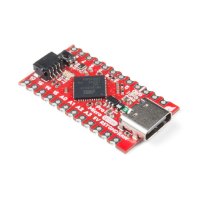ATmega32U4. Most significantly, the serial interfaces of both devices are
wired – the XBee’s ‘DOUT’ pin is connected to the ATmega32U4’s ‘RX’,
and ‘DIN’ is connected to ‘TX’.
XBee’s are controlled and configured over a serial interface. To learn more
about using XBee’s check out their datasheet and various tutorials for help
getting started with these awesomely simple wireless transceivers.
Installing: Windows
Getting the Pro Micro or Fio v3 set up on your computer and in your
Arduino environment can be difficult. Follow along on this page for a step-
by-step guide through the driver installation and Arduino-enabling process.
Windows Driver Installation
A note to Windows 8 users: Before you can install these drivers, you’ll
need to disable driver signature enforcement. Please check out our quick
Disabling Driver Signature Enforcement tutorial for help with that.
Step 1: Download the Driver
Before plugging your board in, get a head start by downloading the
drivers (check the GitHub Repository for the latest files). The same driver
file works for both the Pro Micro and the Fio v3.
Unzip that zip file, and don’t forget where you’ve left its contents. In that zip
file, you should find an INF file, which contains all the information Windows
needs to install the Pro Micro’s driver.
Step 2: Plug in the Pro Micro / Fio v3
When you initially plug the board in, an “Installing device driver software”
bubble notification should pop up in the lower-right corner of your taskbar.
After the green dot circles the grey box a number of times, you’ll probably
get a sad bubble like this:
Page 9 of 2

